Red KnotSanderlingLittle StintTemminck's StintCurlew SandpiperPurple SandpiperDunlinBroad-billed SandpiperRuff
Red Knot🠉
Calidris canutus
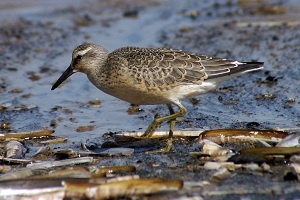
Larger and stockier than the Dunlin, with short legs. Bill quite straight, relatively thick and short. In flight, long wings, narrow white wingbars, and pale grey rump.
Adult breeding: rufous-brown below. Grey and rufous-brown on the upperparts. Legs dark.
Adult non-breeding: White supercilium, chest streaked dark grey, uniform grey above, flanks streaked grey-brown, undertail with grey-brown chevrons.
Juvenile: colouration similar to adult non-breeding, but tinged with yellow-buff on the underparts, and the feathers of the upperparts show dark crescent-shaped subterminal marks, and whitish tips giving a distinctly scaly pattern.
Call: short nasal “wett-wett”.
L. 23-26 cm ; W. 47-53 cm.
Similar species: Sanderling.
©Thomas Galewski
Sanderling🠉
Calidris alba
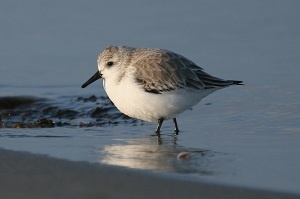
Often seen feeding in winter on beaches, where it runs behind the receding waves, or on coastal mudflats. It is the same size as the Dunlin, but the bill is short and thick, the black legs have no hind toes, and in flight a broad white wingbar can be seen.
Adult in breeding plumage: head and clearly-demarcated pectoral zone spotted with dark. The chest and the upperparts are marked with rufous-brown.
Adult non-breeding: looks very white from a distance. Uniformly very pale grey above.
Juvenile: upperparts blackish with broad whitish fringes, with no rufous-brown colouration, and creating a more uniformly scaly colouring above, with no white “V” as in the Little Stint. Crown dark, contrasting with a distinct pale supercilium. Sides of the neck distinctly marked with dark on an orange-cream background.
Call: a sharp “twit”.
L. 18-21 cm ; W. 36-43 cm.
Similar species: Red Knot, Little Stint, Temminck's Stint.
©Marc Thibault
Little Stint🠉
Calidris minuta
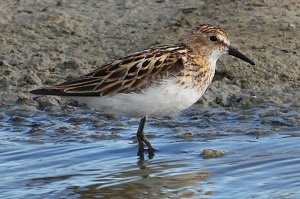
Small wader, one-third smaller than the Dunlin, with a finely-pointed short straight bill. Legs black. The tail is short. An active, ceaselessly-moving wader.
Adult in breeding plumage: red-brown colouration on the upperparts, head, neck, and chest, becoming more greyish throughout at the end of the summer.
Adult in non-breeding plumage: grey above with darker centres to the feathers. Usually only the sides of the chest are grey, more rarely there is a darker pectoral band across the upper chest contrasting with the rest of the underparts, which are white.
Juvenile: the feathers of the upperparts are dark, fairly broadly edged with white (coverts) to rufous-brown (mantle). A clear white “V” on the edges of the mantle.
Call: fairly loud “tit”, given singly or repeated several times.
L. 13.5-15 cm ; W. 27-30 cm.
Similar species: Temminck's Stint, Sanderling.
©Thomas Blanchon
Temminck's Stint🠉
Calidris temminckii
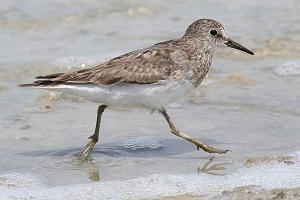
Wader of similar size to Little Stint, but more elongated at the rear, with a longer tail extending a little beyond the wings at rest, slightly shorter legs, and a finer, slightly curved bill. The legs are pale, yellowish, greenish, or brownish. The sides of the tail are white, whereas they are grey in the Little Stint. Most often seen on vegetated mudflats. When disturbed it flies high, zig-zagging while calling continuously. Often recalls Common Sandpiper in colouration in winter and juvenile plumages.
Adult breeding: upperparts brownish, with a few feathers on the mantle and shoulders having black centres and rusty-buff edges.
Adult non-breeding: uniformly grey-brown above; chest grey-brown, forming a breast-band, and contrasting with the rest of the underparts, which are white.
The juvenile is like the adult in non-breeding plumage, but the feathers of the upperparts are clearly edged yellowish.
Call: often-repeated trill, “tssriiiii”.
L. 14-15.5 cm ; W. 34-37 cm.
Similar species: Little Stint, Sanderling.
©Marc Thibault
Curlew Sandpiper🠉
Calidris ferruginea
A little larger than the Dunlin, with the legs (especially the tibiae) longer, a longer neck, and a bill generally longer and evenly curved. In flight, easily distinguished from it by a white patch on the rump.
The adult in breeding plumage is easily distinguished from other small waders by its size, shape, and brick-red colouring on the underparts. In non-breeding plumage, the grey of the upperparts is paler than in the Dunlin, and a clear white supercilium can be seen. The juvenile is greyer than the juvenile Dunlin, and there is no white “V” on the edges of the mantle. In addition, there is a clear white supercilium, and the chest is orange-buff, finely streaked at the sides.
Call: short, loud “tirrrip”.
L. 19-21.5 cm ; W. 38-41 cm.
Similar species: Dunlin, Broad-billed Sandpiper.
©Thomas Blanchon
Purple Sandpiper🠉
Calidris maritima
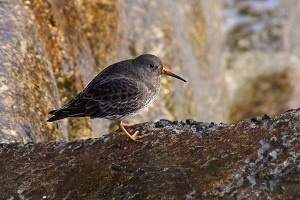
Wader of slightly larger size than the Dunlin, but shorter-legged and squatter, giving it a distinctive plump appearance. Bill the same shape as the Dunlin’s. Tail long, extending past the wingtips. In juveniles and non-breeding adults, the legs are bright brown-yellow, and the bill shows a broad yellowish base.
Adult in breeding plumage: legs greyish-yellow. Dark above. Underparts with chevrons or anchor-shaped markings, reddish grey-brown in colour.
In winter, the adult is dark grey above with broad diffuse anchor-shaped markings below.
Juvenile: scaly above, head grey with a darker crown, chest faintly tawny-coloured, streaked with dark brown as are the flanks.
Call: short “kvitt” or “kvi-it”.
L. 19-22 cm ; W. 37-42 cm.
Similar species: Dunlin, Broad-billed Sandpiper.
©Thomas Galewski
Dunlin🠉
Calidris alpina
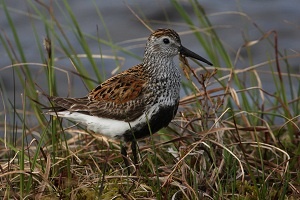
Small wader, size of a starling, with a black bill of variable length (ranging from short and rather straight, like the Little Stint for example, to long and curved like a Curlew Sandpiper). The legs are fairly short (especially the tibiae).
The adult in breeding plumage is distinguished by a black belly patch. The upperparts are dull russet-brown to bright red-brown. The adult in non-breeding plumage shows uniformly greyish-brown upperparts, a fairly well-demarcated pale grey pectoral band contrasting with the white belly. The head is fairly uniform grey-brown, and a short, ill-defined supercilium is visible. Juveniles show a distinct, diffusely-streaked pectoral band, as well as coarse blackish spots on the sides of the belly, while the flanks are uniformly white. The upperparts are dark brown with dirty white and rusty edgings. The head, nape, and upper chest have a brownish-yellow tint. There is no clear supercilium.
Call: a trilled, hoarse “krrrri”.
L. 17-21 cm ; W. 32-36 cm.
Espèces similaires : Curlew Sandpiper, Broad-billed Sandpiper.
©Thomas Galewski
Broad-billed Sandpiper🠉
Limicola falcinellus
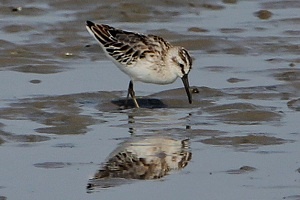
In general, slightly smaller than the Dunlin, with shorter greenish-grey legs. Feeds more slowly (probes in the mud a little like the Common Snipe). Bill long and straight with the tip slightly curved. Shows a double supercilium above the eye. In breeding and juvenile plumages, a wader with fairly dark upperparts.
Adult in breeding plumage: flanks heavily spotted, complete breast-band.
Adult in non-breeding plumage: like the Dunlin, but head pattern different. Juvenile: like the breeding plumage adult, but distinct, well-marked “V” on the mantle, and chest heavily marked on a whitish to brown background.
Call: dry, high-pitched trill.
L. 15-18 cm ; W. 34-37 cm.
Espèces similaires : Dunlin, Curlew Sandpiper.
©Thomas Galewski
Ruff🠉
Philomachus pugnax
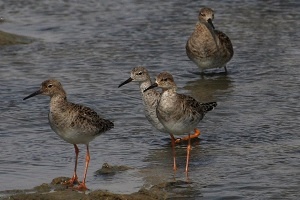
Marked difference in size between males and females, the males being larger. Males are generally a little bigger than the Common Redshank (size approximately similar to the Spotted Redshank), and are more heavily built. The little females are slightly larger than the Dunlin. A fairly long-legged wader, with a small head and a fairly long neck, a big body, and a medium-length, slightly curved bill. In flight, the wingbeats are a little slower and deeper than in other waders of the same size. There is a narrow wingbar, and two oval white patches on the upper tail. The bill and legs are variable in colour (dark brown to reddish for the bill, green-yellow to orange-red for the legs).
Adult breeding: males have an erectile headdress that is seen in May and June, of variable colour, black, red-brown, orange or white, uniform, or broadly barred. This ruff contrasts with the chest and flanks, which have broad black markings. Rest of underparts white. The females are brown, more or less marked with black.
Adult non-breeding: both sexes have identical colouring. Bill and legs usually dark and dull. The overall colouration is brownish-grey, with the feathers of the upperparts having broad darker centres. Chest and flanks grey-brown. Juveniles: like the non-breeding adult, but underparts usually noticeably buffer, and upperparts distinctly scaled.
Call: nearly always silent. Rarely, a low call.
L. 22-32 cm ; W. 46-60 cm.
©Thomas Galewski




.png)
